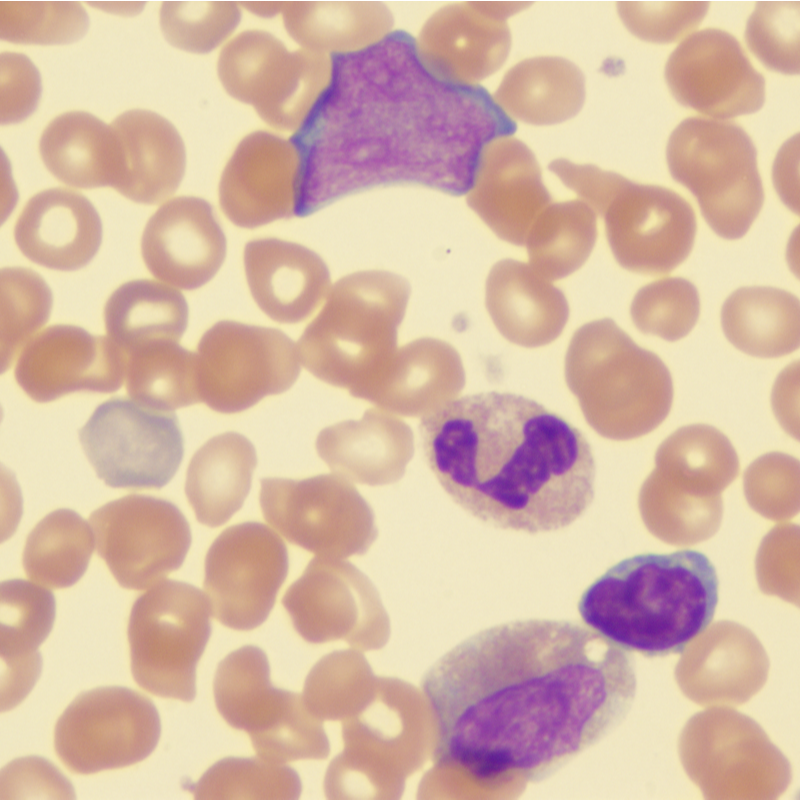
What is myelofibrosis?
Myelofibrosis is a malignant disease of the bone marrow. In this case, due to defective genetic material of the stem cells in the bone marrow, a multiplication of various blood cells occurs. Due to uncontrolled growth of the connective tissue, the bone marrow becomes fibrous in the further course of the disease , which in turn leads to the blood formation shifting to the liver or spleen. Myelofibrosis is rather rare and can develop as a separate disease , primary myelofibrosis, or go hand in hand with another disease , secondary myelofibrosis:
- primary myelofibrosis: It develops due to gene mutations. The disease occurs most frequently between the ages of 50 and 70. Men are affected significantly more often than women.
- secondary myelofibrosis: It occurs in combination with other blood diseases . These include chronic myeloid leukaemia, thrombocythaemia and polycythaemia vera. Also in patients with tuberculosis, pulmonary hypertension, lupus, HIV infection, as well as in sufferers who have developed metastases in the bones due to an advanced cancer.
How does myelofibrosis manifest itself?
In many cases, there are no symptoms for years. However, in some sufferers, anaemia develops quite quickly, which means that the number of platelets in the blood gets lower and lower. Likewise, leukaemia develops quickly. Fatigue, tiredness, malaise and weight loss are the first signs of myelofibrosis. Similarly, symptoms such as night sweats and fever develop. Because the number of white blood cells decreases, patients become more susceptible to infections, i.e. they suffer more from infections. The decreasing number of blood platelets makes the patient more susceptible to bleeding. As the disease progresses, the growth of the liver and spleen causes pain in the abdomen. The increased pressure in the portal vein can cause bleeding in the oesophagus and from varicose veins.
How is myelofibrosis diagnosed?
In most cases, myelofibrosis develops over a long time without getting any symptoms at all. For this reason, it is often the case that an initial suspicion arises during a routine examination by a GP, for example, when the blood values are examined. If there are further indications, such as an enlarged liver or spleen , a referral should be made to a specialist who specialises in blood disorders.
With the help of the anamnesis interview, the doctor can specifically check which typical symptoms of myelofibrosis are present and whether such a condition or a similar one has already occurred in the family. Through the ultrasound examination of the abdomen, the doctor can see whether the spleen or liver are enlarged. Another examination will be that of the blood . A large blood count will provide information about the number of functioning and immature blood cells . A gene mutation can be detected with the help of a molecular genetic blood cell test.
In order for myelofibrosis to be diagnosed unequivocally and without doubt, a bone marrow examination is essential. During a short procedure under local anaesthetic, a tiny amount of the fluid part of the bone marrow is removed with the help of a syringe. This sample is analysed in the laboratory to determine the nature and possible changes in the cells.
How is myelofibrosis treated?
In general, therapy for myelofibrosis is aimed at reducing the symptoms and maintaining the patient's quality of life. Despite the most modern forms of therapy, a cure is not possible in most cases . The only possibility to cure the disease is stem cell transplantation. However, this is associated with enormous risks and is by no means suitable for every patient .
Not every patient has to be treated with medication immediately. Often, the course of the disease is waited for and checked at regular intervals. A patient suffering from myelofibrosis will only receive treatment when the first symptoms appear. In the initial phase, it may be necessary to use drugs that prevent the formation of new blood cells, because the bone marrow still produces enough blood cells in this phase. As the disease progresses, however, fewer blood cells are formed and anaemia develops. In this case, blood transfusions are supposed to help maintain the number of red blood cells and relieve symptoms such as tiredness, paleness and breathing difficulties.
Irradiation of the spleen is considered when a reduction in the size of the spleen can relieve gastrointestinal symptoms. However, the spleen will increase in size again over time, so this form of therapy may need to be repeated. If the spleen, especially in the late stages of the disease, is severely enlarged, removal of it can help relieve symptoms such as diarrhoea, constipation, abdominal pain. However, removal of the spleen carries the risk of thrombosis.
At present, the only treatment method to cure this disease is stem cell transplantation. In this procedure, healthy stem cells from the blood or bone marrow of a donor are transferred to the affected person. To prevent the foreign bone marrow from being rejected , the affected person is given immunosuppressants for the rest of his or her life after the therapy . The absolute highest goal of this treatment is that the transferred stem cells can form functional blood cells again themselves .
What is the prognosis for myelofibrosis?
The prognosis of the disease depends on the course of the disease, which is completely individual. Among other things, this includes factors such as the patient's age, the symptoms and the blood values. Another important factor for the prognosis is whether the patient responds at all to the chosen therapy, and if so, how well the patient responds. Despite very modern and different treatment methods, myelofibrosis cannot be cured with medication, but only with the help of a suitable stem cell transplant. In about 20 % of all patients myelofibrosis develops into acute leukaemia despite treatment.
